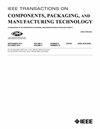Investigation of a Novel Symmetric-Structure-Based MEMS Piezoresistive Accelerometer
IF 3
3区 工程技术
Q2 ENGINEERING, ELECTRICAL & ELECTRONIC
IEEE Transactions on Components, Packaging and Manufacturing Technology
Pub Date : 2025-08-04
DOI:10.1109/TCPMT.2025.3595152
引用次数: 0
Abstract
In this article, a novel symmetric-structure-based silicon microelectromechanical systems (MEMS) piezoresistive accelerometer is proposed. Compared to conventional structures based on multiple support beams and hanging-seismic-mass, the symmetric-structure not only reduces cross-axis output but also ensures lower stresses in the flexures when subjected to cross-axis acceleration inputs. It increases the ratio of the fracture acceleration limit in the cross-direction to that in the sense-direction, from approximately 5.8 to 24. Additionally, it improves the ratio of the second to the first mode resonance frequency from approximately 2.2 to 10.5, which can improve survivability of the structure over a much wider bandwidth against resonance of the second mode. The new structure was fabricated by bonding two silicon-on-insulator (SOI) wafers, each containing complementary halves of the structure. This article presents the configuration details of the structure, along with analytical and finite element analysis (FEA) results to estimate deflections, stresses, modal frequencies, and mode shapes. Additionally, the MEMS fabrication process details, packaging, and test results of X-ray imaging, scanning electron microscope (SEM) imaging, natural frequency measurement using laser doppler vibrometer (LDV), sensitivity test, and so on, at die and package level are discussed.一种新型对称结构MEMS压阻式加速度计的研究
提出了一种基于对称结构的硅微机电系统(MEMS)压阻式加速度计。与基于多支撑梁和悬震质量的传统结构相比,对称结构不仅减少了跨轴输出,而且在受到跨轴加速度输入时保证了较低的挠曲应力。横向裂缝加速极限与纵向裂缝加速极限之比由5.8左右增加到24。此外,它将第二模与第一模的共振频率之比从大约2.2提高到10.5,这可以提高结构在更宽的带宽上抵抗第二模共振的生存能力。这种新结构是通过结合两个绝缘体上硅(SOI)晶圆来制造的,每个晶圆都包含该结构的互补部分。本文介绍了结构的配置细节,以及分析和有限元分析(FEA)结果,以估计挠度,应力,模态频率和模态振型。此外,还讨论了MEMS的制造工艺细节、封装以及在芯片和封装层面的x射线成像、扫描电子显微镜(SEM)成像、激光多普勒测振仪(LDV)固有频率测量、灵敏度测试等测试结果。
本文章由计算机程序翻译,如有差异,请以英文原文为准。
求助全文
约1分钟内获得全文
求助全文
来源期刊

IEEE Transactions on Components, Packaging and Manufacturing Technology
ENGINEERING, MANUFACTURING-ENGINEERING, ELECTRICAL & ELECTRONIC
CiteScore
4.70
自引率
13.60%
发文量
203
审稿时长
3 months
期刊介绍:
IEEE Transactions on Components, Packaging, and Manufacturing Technology publishes research and application articles on modeling, design, building blocks, technical infrastructure, and analysis underpinning electronic, photonic and MEMS packaging, in addition to new developments in passive components, electrical contacts and connectors, thermal management, and device reliability; as well as the manufacture of electronics parts and assemblies, with broad coverage of design, factory modeling, assembly methods, quality, product robustness, and design-for-environment.
 求助内容:
求助内容: 应助结果提醒方式:
应助结果提醒方式:


